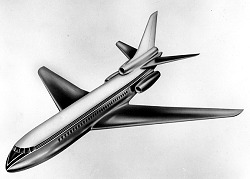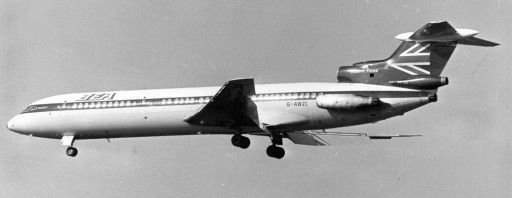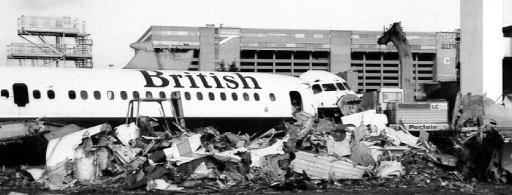
History of the Hawker Siddeley Trident
The Trident was originally conceived by de Havilland in the late 1950s as the DH 121 in response to British European Airways (BEA)'s request for a new short to medium haul haul jet airliner, in competition with the Vickers VC-11. The DH 121 was the winning proposal and development of the aircraft began. At the time, speed was one of the most important considerations in airliner design so the aircraft was designed with a low drag wing, with the engine mounted at the rear of the aircraft so the wing was kept as clean as possible. de Havilland became part of the Hawker Siddeley (HSA) group in the government forced mergers in the industry in 1960.
 |
| The DH 121 |
The original DH 121 was a reasonably large aircraft with a high passenger capacity but due to a downturn in the air travel market, BEA requested that the aircraft's dimensions be reduced. As a result the aircraft now seated far fewer people and was to be powered by three Rolls Royce Spey engines as opposed to the planned Medways. The first Trident 1c aircraft entered service with BEA in 1964, having first flown in 1962. The aircraft performed well and was reliable, but BEA soon realised that they had made a mistake with the specification and that their original plan for the larger aircraft was the one that should have been carried through. Hawker Siddeley responded first with the 1E variant, primarily for the export market and the 2E for BEA, featuring uprated engines, larger wing span, improved high lift devices (slats) and great capacity and range. For many the 2E was the definitive variant of the aircraft.
 |
| Trident 1E, image courtesy Neil Lomax Collection |
Whilst export orders for the aircraft were slow and not plentiful, China purchased a Trident from Pakistan International Airways (PIA) and as a result placed an order with HSA for more. Meanwhile, BEA again required a larger aircraft, several options were explored including the purchase of American Boeing 727 aircraft (a design inspired by the Trident, to go on to be one of the best selling aircraft of all time) but the government was insistent they should "buy British". HSA came up with two proposals, the HS 132 and HS 134, based on the Trident airframe, but with larger capacity and other improvements. The HS 134 concept bares remarkable similarity to today's Boeing 757, but in the end, for reasons of cost, it was decided to build another uprated version of the Trident. The new model, the 3B, was the first to feature a stretched fuselage, which could carry up to 180 people and a further increase in wing span. It used the same engines as had been used in the 2E, but they were supplemented by a Rolls Royce RB162 "boost" engine to increase the total thrust on take off. The Trident had always had a weak point in this area and was nicknamed the "gripper" by pilots for the difficulty with which it took to the air. The low drag wing also produced limited lift on takeoff with the consequence that although once airborne, it was one of the fastest subsonic airliners, at speeds below 225 knots (IAS), it high lift devices (flaps and slats, or leading edge droops in the case of the 1c) to get it and keep it airborne.
 |
| A Trident 3B of BEA which became British Airways in 1974. Neil Lomax Collection |
A total of 117 aircraft were sold with the last aircraft, G-BBWH, being built in 1978 destined for CAAC the Chinese state airline. Tridents served with BEA through the 1960s and 1970s and its successor, the merged British Airways began retiring the oldest aircraft in 1976 with the final 3B variants retiring ten years later. Most were simply cut up and scrapped, some were used for fire crew training at airports around the UK and were destroyed. A few have been preserved, both in the UK and in China and a number of others have been used for various training duties, mainly for airport fire services and many these have now been broken up.
 |
| Tridents being broken up at Heathrow, probably around 1984 |
Elsewhere, four ex-BA aircraft were sold to a company in Zaire but these were all scrapped by 1989. The Chinese aircraft tended to leave service with their national airline to join their air force. It is believed that they may have flown until 1998.
The Tridents were assembled at the de Havilland site at Hatfield, Hertfordshire, UK, becoming a Hawker Siddeley Aviation site when the individual company names were dropped in 1963 and subsequently a British Aerospace site during the nationalisation of the British aircraft industry in 1978 and consequent merger of HSA with the British Aircraft Corporation (BAC). After the end of production of Tridents at Hatfield, assembly work continued with the new BAe (HS) 146 and design work on the 125 and Airbus projects. This continued into the 1990s, when the Executive Jet division of British Aerospace was sold to US firm Raytheon and production of the BAe 146 was switched to Woodford, Manchester. Today, the site has been sold for development and little remains of this once important part of the British aircraft industry.